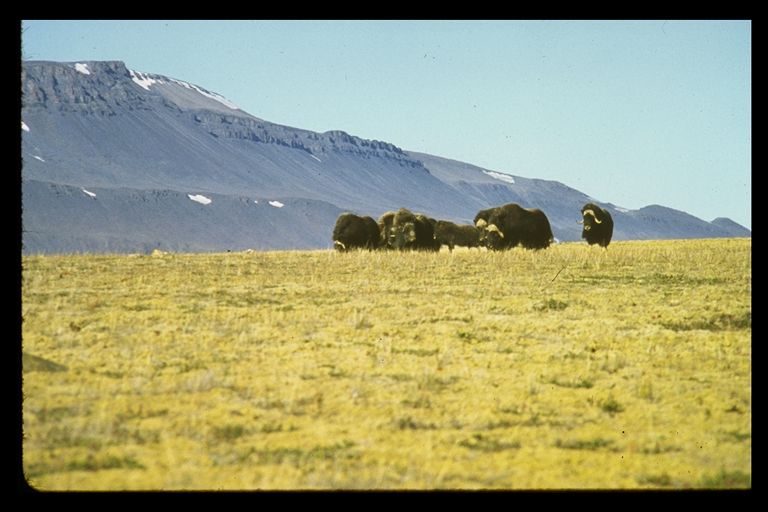
Muskox herd, Eastern Axel Heiberg Island, July 1982. [1]
A muskox herd, about 12 animals. Calves are hiding between the females, the bull separate on the right, keeping a watchful eye. They are about the run off.
In most of the large valleys of Ellesmere Island and Axel Heiberg Island there is a single muskox bull or even a herd of muskox. A herd consists of a big dominant bull, 5-8 mature females, 2-3 calves and 4-5 adolescents. The number of mature females seem to depends on the bulls managerial talents, the bigger the bull, the more females.
Approaching a muskox herd is not without risk. The herd forms a half-circle and the dominant bull stands in front. You can approach them up to 200 meters, if they let you, as they usually already run off at a larger distance. When you get closer, the dominant bull starts snoring and digging its hooves into the ground and you better leave if you do not want to be chased off or even thrown in the air by its massive head and horns.
Fred, the lonely muskox bull on Whitsunday Bay, Eastern Axel Heiberg Island. [1]
Waking up in the morning with a muskox herd [1] of 10-14 animals lying close to the tent is a unique experience. At night the herd may decide to seek shelter in one of their favourite, protected valleys and happens to settled close to our tents. Our preferences are similar, we always try to camp in a sheltered, grassy flat spot and preferably close to a pond.
You can take your time to observe them through a tent opening as they have poor eye-sight. As soon as you get out of the tent, you loose the camouflage of the tents. They will spot you and react in a panic as we have the size and movements of wolves in ambush. They quickly run off at an impressive speed, preferably up-hill, just like the white hares. The stampede led by the dominant bull lasts only a few minutes and they regroup into a defensive half-circle higher up.
Lonely bulls can be approached closer, up to 50 meters.
“Fred”, the lonely muskox bull on Whitsunday Bay, Eastern Axel Heiberg Island.
Getting closer, the bull will just look at you, but at 20 m he will also starts snoring, bending his head and digging his hooves into the ground. Time to quickly take the closest picture and leave, unless you are a Canadian “Jackass” and want a picture being chased like Steve [1].
Skeletons of muskox are common [1]. The tough skull and horns preserves best [1]. A small heap in a sheltered valley with exceptionally high and healthy grass tends to have a muskox skull in it the core which serves as a fertilizer.
Arctic wolves chasing muskox. Photograph by Jim Brandenbug.